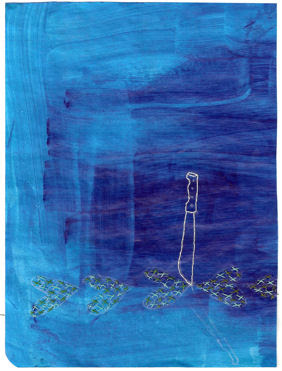(writings about belongings, marks, and other new video works):
They’re first about land and the body, my relationship to land. What the land gives and what our bodies know (both being full of deep knowledge). There is also how we make marks, how we mark our existence in this world. I was thinking a lot about migration and immigration as well. Crossings. Of borders and seas. What is it to cross an ocean? Does the water remember our existence? And how? And how are our own bodies marked with the crossings of people we don’t know. People who we know could be us. Are us.
What is the rhythm of our presence in this world? When we walk does the sound reverberate infinitely, endlessly? How does that sound look?
And the masquerade. I am forever interested in the mask and where that takes us. The space between the body and the spirit. Covering and opening. And what it feels like for the earth to put a mask on.
***
I saw the "Eternal Ancestors: The Art of the Central African Reliquary" show at the Met recently. As I walked through the exhibit I kept thinking, I must not be remembering the definition of reliquary. We are walking through wooden statues dripping with oil, ancestor figures sculpted in metal, stitched dolls that are consulted for important community matters. From the museum catalogue:
“Yet another distinctive genre consists of Bwende and Bembe soft sculptures from the Republic of Congo, with their emphasis on a vibrant red palette, strategic use of contrasting textile patterns, and grand cosmic gestures that announce their role as active intermediaries with the divine. Among the most spectacular and rare examples is a life-size Female Figure by the Bwende master Makosa of Kingoyi that was collected by the Swedish missionary Efraim Andersson in 1938 (Museum of World Culture).”
Soft sculpture? Okay. With the bones of an ancestor inside. The figure, measuring well over 7 feet high is put into the earth during a burial ceremony.
And the un-burying? How does one ‘collect’ the body of another’s dead? What does it take to excavate something so large—both physically and spiritually. Is it excruciating? Does it require amnesia? Or the leaving of one’s own body? Complex like reparations and repatriation.
So, excavation. What do we excavate? And when and why? And how? Can anger be removed from the body? Cut out and photographed? Does it emerge lovingly? Makes me think of Ogun, the Yoruba god of iron and war. He also has a big heart. So while he is fierce and independent, he is very loving, sensitive. Thinking of creating a dance for Ogun.
(Must we undergo constant excavation? And taking, even after the body. Perhaps this is one of the roots that explains my mixed emotions when I come upon the works of Kara Walker and Wangechi Mutu and even Ghada Amer. What would you do without the oppressor? Or must we always be broken or breaking?)
***
I am deeply interested in how we, as artists, create, discover our own language. And how these languages become creoles. The crossings are the creoles that we speak. And so to Sun Ra and Maya Deren:
Sun Ra, from Space is the Place (1974)
Maya Deren, from Meshes of the Afternoon
***
That should really be the measure of success: if you can be in your body.
Nigerian Egungun Dancers
The Lovely Willie Ninja
New York City Breakers featured on Graffiti Rock
Ugandan Marimba Dancing
Ag'ya, Martinique's Combat Dance, 1936, filmed by Katherine Dunham
Katherine Dunham Dancing with Talley Beatty
***






















_2007.jpg)








